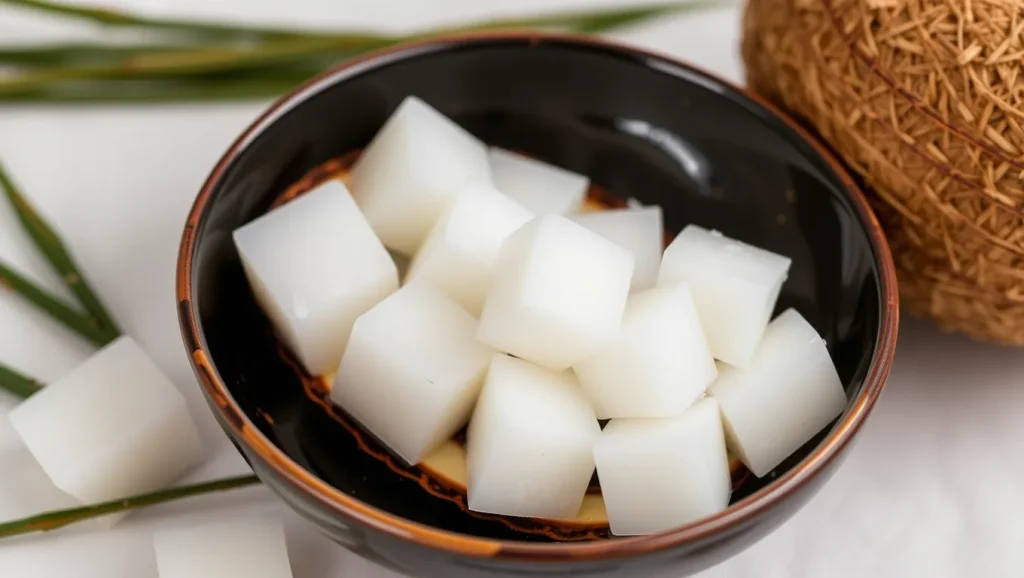
Nata de coco, a chewy, jelly-like food product made from fermented coconut water, is a staple in many desserts and beverages. Originating from the Philippines, it has gained global popularity due to its unique texture, health benefits, and versatile culinary applications. If you’re looking to start a profitable food business, nata de coco production is an excellent choice—especially in coconut-rich regions.
This comprehensive guide will walk you through everything you need to know about starting a nata de coco business, including investment costs, step-by-step production processes, pricing strategies, and registration requirements.
What is Nata de Coco?
Nata de coco is a fermented food product created using Acetobacter xylinum bacteria. The result is a thick, translucent, and gelatinous food item rich in dietary fiber and free from cholesterol and unhealthy fats. It is commonly used in:
- Desserts & sweets – Served as a topping for ice cream, yogurt, or sweetened as candy.
- Fruit cocktails & salads – Adds texture to fruit mixes and beverages.
- Bubble tea & drinks – Frequently used in milk teas and fruit-infused beverages.
- Gourmet dishes – Innovatively incorporated into various dishes for added texture.
Why Start a Nata de Coco Business?
Starting a nata de coco business is a profitable venture due to its low production cost, high demand, and export potential. The global market for nata de coco was valued at approximately USD 800 million in 2023 and is projected to reach USD 1.35 billion by 2033, growing at a 5.3% CAGR (FactMR).
Other benefits of starting this business include:
✅ Low startup costs – Basic ingredients and equipment are affordable.
✅ Strong demand – Used in the food industry worldwide.
✅ Sustainable business – Utilizes coconut water, reducing waste.
✅ Scalable business model – Start small and expand as demand increases.
Investment Costs for a Nata de Coco Business
Below is an updated breakdown of the estimated startup costs:
1. Equipment and Utensils
| Item | Quantity | Unit Cost (₱) | Total Cost (₱) |
|---|---|---|---|
| Weighing Scale | 1 | 200 | 200 |
| Straining Cloth | 1 | 30 | 30 |
| Stainless/Enamel Kettle | 1 | 1,000 | 1,000 |
| Fermenting Basins or Jars | 30 | 62 | 1,860 |
| Total Cost (Equipment) | 3,090 |
2. Packaging Materials
| Item | Quantity | Unit Cost (₱) | Total Cost (₱) |
|---|---|---|---|
| Sterilized Glass Jar with Cap | 1 | 13 | 13 |
| Cap Sealer | 1 | 0.30 | 0.30 |
| Total Packaging Cost per Jar | 13.30 |
3. Raw Materials
| Item | Quantity | Unit Cost (₱) | Total Cost (₱) |
|---|---|---|---|
| Fresh Grated Coconut (1 kg) | 1 | 60 | 60 |
| Glacial Acetic Acid (400 ml) | 1 | 120 | 120 |
| Refined Sugar (2 kg) | 1 | 80 | 80 |
| Tap Water | As required | – | – |
| Nata Starter (2 liters) | 1 | 50 | 50 |
| Total Raw Material Cost | 310 |
Step-by-Step Guide to Making Nata de Coco
1. Preparing the Nata de Coco Grower
1️⃣ Mix grated coconut with water and extract the milk using a straining cloth.
2️⃣ Dissolve sugar in the coconut milk, then add glacial acetic acid and the nata starter. Mix thoroughly.
3️⃣ Pour the mixture into clean, sterile fermenting basins (about 2 inches deep).
4️⃣ Cover with manila paper and let it ferment undisturbed for 8-10 days.
5️⃣ Harvest the nata and wash it thoroughly.
2. Processing Nata de Coco in Heavy Syrup
1️⃣ Soak the harvested nata in water for 2 days, changing the water frequently to remove acidity.
2️⃣ Boil the nata pieces in water, then drain and weigh.
3️⃣ Add 0.75 kg of refined sugar per 1 kg of nata, mix thoroughly, and let it stand overnight.
4️⃣ Boil the nata in syrup for 10-15 minutes until it becomes transparent.
5️⃣ Prepare the final syrup by boiling 2 parts water to 1 part sugar and adding 0.1% citric acid.
6️⃣ Pack the nata into dry, sterilized jars, pour in the hot syrup, remove air bubbles, and seal.
7️⃣ Sterilize the jars for 30 minutes, cool, label, and store.
Costing and Pricing Strategy
Production Cost Breakdown
| Cost Component | Amount (₱) |
|---|---|
| Direct Raw Materials Cost | 4,800 |
| Packaging Material Cost | 12,372 |
| Labor (₱400/day x 4 days) | 1,600 |
| Total Direct Cost | 18,772 |
| Indirect Cost (Utilities) | 1,600 |
| Total Production Cost | 20,372 |
Suggested Retail Price (SRP)
| Bottle Size | Production Cost (₱) | 20% Markup (₱) | Suggested Price (₱) |
|---|---|---|---|
| 12 oz. Bottle | 21.65 | 4.33 | 25.98 |
| Market Price | ₱28.75 – ₱36 |
Business Registration Requirements in the Philippines
To legally operate your nata de coco business, ensure compliance with the following:
✅ Business Name Registration – Register at DTI Business Name Registration System.
✅ Mayor’s/Business Permit – Apply at your local municipal/city hall.
✅ BIR Registration & TIN – Secure a Taxpayer Identification Number (TIN) via BIR.
✅ BFAD/FDA Certification – Required for food processing businesses (FDA Philippines).
Where to Get Support and Financing
💰 Financing Options:
🎓 Training & Technical Assistance:
- DOST-STII (DOST)
- DA-BPI (Department of Agriculture)
- DTI-PTTC (DTI Training Center)
Final Thoughts
Starting a nata de coco business is a profitable opportunity with low startup costs and high demand. By following this guide, you can set up a successful venture while tapping into both local and export markets.
Are you ready to start your nata de coco business? Let us know in the comments below!


how can i purchase the nata starter? What is the packing size? Please email me the information.
Good day! May I kindly request for a list of possible supplier of equipment to be used as slicer/cutter of nata de coco. The nata de coco will be used as sinker for milk tea and other beverages alike.
Your reply will be greatly appreciated.
If you need bottles packaging, please visit the website – www.synergospackaging.com . Thanks! God bless!